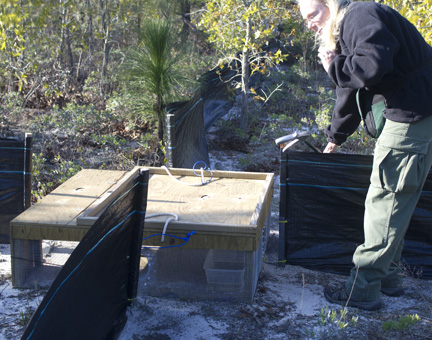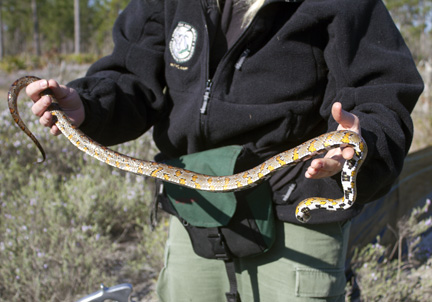
FWC documents species of greatest conservation need
Every day is a new discovery for Charlene Hopkins, wildlife biologist with the Florida Fish and Wildlife Conservation Commission. As the field biologist for the Ephemeral Pond Sampling Project in the Point Washington State Forest and Pine Log State Forest, Hopkins’ job is to document the presence of imperiled reptile species in the forests.
In 2002, the project started in the two upland sandhill pine forests with emphasis on documenting the presence of the reticulated flatwoods salamander (Ambystoma bishopi). In 2012, the project has expanded to include detecting the presence of the Federally and State Threatened eastern indigo snake (Drymarchon corais couperi), and the State SSC Florida pine snake (Pituophis melanoleucus mugitus) as a priority.

A variety of reptiles and small mammals have been captured and released during the project to date. Hopkins documents all data including hair samples in her reports.
The trapping systems in the forests are located near wetland areas and ephemeral ponds as reptile populations typically exist within 200 meters of these areas.
Below is Hopkins’ detailed description of the project’s trapping system:
Because of their size, large terrestrial snakes can be difficult to capture using traditional survey methods. Use of traps specifically designed to capture these large terrestrial species may prove to be the most effective method for documenting their numbers on Point Washington WMA. Currently, we have four box-style snake traps, installed in conjunction with four 100-foot drift fence arms. Traps were placed in spatially distinct upland sandhill habitats, which were chosen based on their vegetation composition and structure, as well as proximity to mesic habitats. Two 5-gal buckets were installed on each side of the four arms of drift fence leading to the box trap (eight total buckets per array) to aid in capturing small- bodied terrestrial snakes, lizards, small mammals, and amphibians. Buckets are maintained with 1-2 inches of soil and a 3 x 5-inch sponge saturated with water to help prevent dessication. The bottoms of buckets are perforated to allow excess rainwater to drain and to prevent drowning of captured animals. Box traps are maintained with a 1.5-gal water tray, and are checked daily beginning in the early morning to prevent dessication and undue stress on captured animals. Traps contain a 22-ounce tin can filled with dried grass to act as refugia for any small mammals captured. All traps are built with a side access door capable of being propped open when traps are not in use.
